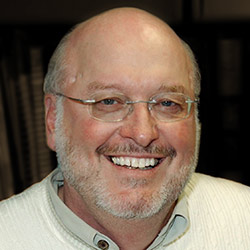
David B. Gray, PhD, a professor of occupational therapy who worked tirelessly to improve the lives of people with disabilities, died Thursday, Feb.12, 2015, in St. Louis of an apparent heart attack. He was 71.
Gray, who also was a professor of neurology at Washington University School of Medicine in St. Louis, became motivated to change what it means to be disabled after he was paralyzed in 1976 in a fall from a roof that broke his neck. He went on to work for several agencies at the National Institutes of Health (NIH), was appointed director of the National Institute on Disability and Rehabilitation Research by President Ronald Reagan and was an important advocate for the Americans with Disabilities Act of 1990. He was present when President George H.W. Bush signed the bill into law.
Gray joined the School of Medicine faculty in 1995 to conduct research and teach courses on social issues and disability.
“David has made a huge impact on our program, our profession and the disability movement,” said Carolyn M. Baum, PhD, the Elias Michael Executive Director of the Program in Occupational Therapy at Washington University. “He has supported the growth of many of our faculty and students, and his work has challenged so many ideas of disability. Many people’s lives are vastly better because of his work and efforts.”
Gray was well-known for thinking outside the box. He was the visionary behind the internationally recognized Enabling Mobility Center, now called the Health and Wellness Center, located at Paraquad, an independent living center in St. Louis. The center serves as a resource to promote overall physical health and emotional wellness for people with disabilities. There, people with mobility limitations work out with trained professionals in a fully accessible gym, are evaluated on a mobility skills course and test new assistive technology. They also learn about personal health and wellness and are able to acquire pre-owned medical equipment at low cost.
Gray was passionate about developing personalized interventions to help individuals fully participate in their everyday life activities. He developed outcome measures with participation at the core, and he tested interventions to improve community participation for people with disabilities. His work on measures of community participation and the role that the environment can play in determining whether a person with disabilities can fully participate in an activity is internationally recognized.
Following Gray’s death, a former student noted in a Facebook post, “If heaven didn’t have decent curb cuts before, you can be damn sure it does now.”
Kerri Morgan, an instructor in occupational therapy, said: “Dr. Gray has influenced minds, policy, programs and rehabilitation processes through his leadership, science and advocacy for disability. He was a big thinker and conceptualized research ideas that were usually way ahead of his time.”
Gray focused his work on what was needed in the disability community rather than what was easy, according to students. He realized unemployment was a major problem with people with mobility limitations, so he developed a program with the Great Plains Disability and Business Technical Assistance Center to study people with disabilities who had been successfully employed for two years. He created videos to tell their stories and made the videos available to potential employers.
Additionally, Gray developed programs for parents with mobility limitations. As a parent with a disability, Gray received requests for support, assistance and advice from other parents with disabilities. He felt strongly that parents could benefit from adaptive strategies to bathe, feed, dress and carry their children.
“Dr. Gray built a team of professionals and sent accomplished students into the field who will continue to have an impact on communities throughout the world,” said Carla Walker, an occupational therapist. “His legacy is true change and opportunity for meaningful participation of persons with disabilities.”
Gray was born in Grand Rapids, Michigan, the second of four children. His father, Fred Gray, was an obstetrician, and his mother, Marian Bertsch Gray, was a medical social worker.
He graduated from Lawrence University in 1962 with a bachelor’s degree in psychology. Gray later earned a master’s degree in experimental psychology from Western Michigan University, in 1970, and a doctorate in psychology and genetics from the University of Minnesota, in 1974.
A memorial symposium, originally planned as a retirement symposium, will be held May 22 on the School of Medicine Campus. A memorial service will be held at 4 p.m. May 21 at Graham Chapel on the Danforth Campus.
In addition to his wife of 47 years, Margaret “Margy” E. Gray, Gray’s survivors include his son, David W. Gray (Alicia Yamamoto); two daughters, Elizabeth Gray (James Nackley) and Polly (Bill) Payne; a sister, Priscilla Laula (Sandy Kohn); two brothers, Fred Gray and William (Carol) Gray; and two grandchildren.
Memorial contributions may be made in David Gray’s name to the Accessible Health and Wellness Center, care of Paraquad, 5240 Oakland Ave., St. Louis, MO 63110.
Comments and respectful dialogue are encouraged, but content will be moderated. Please, no personal attacks, obscenity or profanity, selling of commercial products, or endorsements of political candidates or positions. We reserve the right to remove any inappropriate comments. We also cannot address individual medical concerns or provide medical advice in this forum.